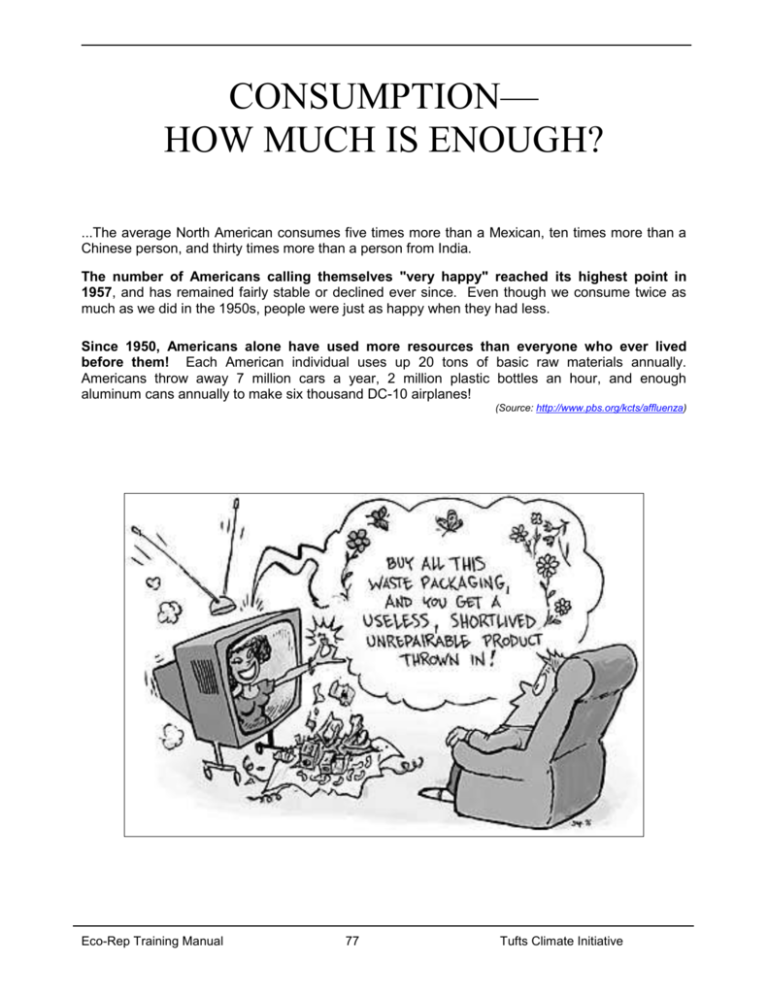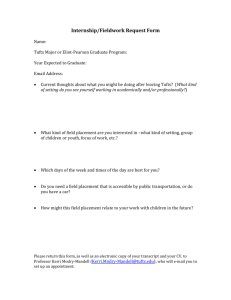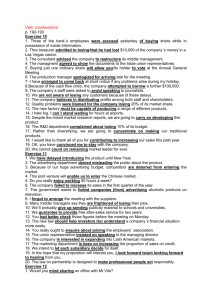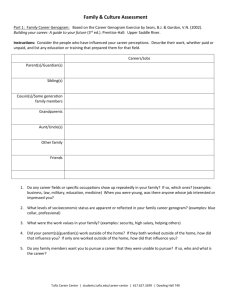Consumption - Office of Sustainability
advertisement

CONSUMPTION— HOW MUCH IS ENOUGH? ...The average North American consumes five times more than a Mexican, ten times more than a Chinese person, and thirty times more than a person from India. The number of Americans calling themselves "very happy" reached its highest point in 1957, and has remained fairly stable or declined ever since. Even though we consume twice as much as we did in the 1950s, people were just as happy when they had less. Since 1950, Americans alone have used more resources than everyone who ever lived before them! Each American individual uses up 20 tons of basic raw materials annually. Americans throw away 7 million cars a year, 2 million plastic bottles an hour, and enough aluminum cans annually to make six thousand DC-10 airplanes! (Source: http://www.pbs.org/kcts/affluenza) Eco-Rep Training Manual 77 Tufts Climate Initiative Is this the American Dream? (the following pages were adapted from a publication of the New Roadmap Foundation, www.newroadmap.org) Increase in average daily TV viewing since 1960: 39% American parents spent 40% less time with their children in 1991 than they did in 1965. Percentage of college freshmen that reported thinking it is essential to be well off financially: 1967: 44% 1987: 76% Percentage of college freshmen that reported thinking it is essential to develop a philosophy of life: 1967: 83% 1987: 39% Percentage of American teenage girls who report store-hopping as favorite activity: 93% Average time spent shopping per week: 6 hours Time spent playing with children per week: 40 minutes How much we waste The waste generated each year in the U.S. would fill a convoy of 10-ton garbage trucks 145,000 miles long -over halfway to the moon. By the time a baby born the United States reaches age 75, he or she will have produced 52 tons of garbage, consumed 43 million gallons of water, and used 3,375 barrels of oil. ECO-Rep Training Manual 78 Tufts Climate Initiative Is our dream a nightmare for others? Percentage of the word's population comprised of Americans: 5% Percentage of the world's resources consumed by Americans: 30% The amount of energy used by one American is equivalent to that used by: 3 Japanese 6 Mexicans 14 Chinese 38 Indians 168 Bengalis 531 Ethiopians Percentage of fossil fuel used annually that is consumed by the U.S.: 25% Percentage of all humans who own a car: 8% Percentage of American households who own one or more cars: 89% Average annual income of the 3.3 billion people in the global "middle class": $700 - $7,500 Average annual income of the 1.1 billion people in the global "consumer class": over $7,500 The consumer class takes home 64% of the world's income. Is our dream a nightmare for the earth? In the last 200 years the United States has lost: 50% of its wetlands 90% of its northwestern old-growth forests 99% of its tall grass prairie and up to 490 species of native plants and animals with another 9,000 now at risk Is our dream a nightmare for us? Increase in consumer debt in the 1980s: 140% The typical American household carries $8,570 of non-mortgage personal debt. Number of individuals filing for bankruptcy in 1992: 900,000 -- triple that of 1981 In the industrialized world, the U.S. ranked 22nd in terms of its income equality between the rich and the poor. (First being the most income-equal.) Out of all industrialized countries, the income disparity between the rich and the poor is greatest in the United States. ECO-Rep Training Manual 79 Tufts Climate Initiative New values, old habits From a nationwide 1991 survey: 8 out of 10 Americans regarded themselves as "environmentalists" and half of those said they were "strong" ones. 8 out of 10 voters said protecting the environment is generally more important than keeping prices down. Percentage of Americans in 1990 who believed that a "major national effort" was needed to improve the environment: 78% Percentage who were actively working toward solutions: 22% Advertising All spoof ads are from www.adbusters.org American teenagers are typically exposed to 360,000 advertisements by the time they graduate from high school. The average American will spend watching TV commercials one entire year of his or her life. The line between "commercial" and "news" is almost indistinguishable in many a TV program and newspaper. FAO Schwarz, for example, claims not to spend a single penny on advertising, yet generates $10 million dollars in media coverage by creating "newsworthy" events such as Elvis Impersonators jumping out of the sky to launch the new "Barbie loves Elvis" doll and the opening of their Las Vegas store, complete with a 46 foot high Trojan Horse. Entertainment and commercials have morphed into one. Today brand names saturate almost every sitcom and movie. (excerpted from Selling Discontent, by Anna White, http://www.newdream.org/commerc/discontent.html) ECO-Rep Training Manual 80 Tufts Climate Initiative What’s the Impact of all this Advertising? (excerpted from Selling Discontent, by Anna White, http://www.newdream.org/commerc/discontent.html) 1. You think about buying things more. Michael Jacobson, author of Marketing Madness and Executive Director of the Center for Science in the Public Interest says, "Just being bombarded with advertising, one thinks more about buying things than one otherwise would...If an equal amount of money was spent to encourage [more socially beneficial] activities it would have a big impact." 2. The effect is so pervasive, it is hard to understand the true impacts. Kalle Lasn, editor of Adbusters, "When the average North American grows up receiving so many commercial messages each day, it changes one's personality, and the way one eats, dresses, gets around...it biases the whole lifestyle and whole culture." 3. You are less, not more content. Former advertising executive Ray Locke expresses the sentiment of many in the business, " Advertising makes people discontented. It makes them want things they don't have. Without discontent, there is no progress, no achievement." 4. It’s devastating to the environment. One of the many problems with a culture based on relentless advertising and hyperconsumerism is the grim environmental effect. Matthias Wackernagel, the author of Our Ecological Footprint, says that if everyone consumed at the level of the average North American, it would take four extra planets to provide the necessary resources to survive. Globalization and the marketing of the American consumer lifestyle provokes millions of global consumers to suddenly "need" SUVs, big screen TVs and closets of stuff. What Can You Do? (excerpted from Selling Discontent, by Anna White, http://www.newdream.org/commerc/discontent.html) You still have power. Of course, the only force that can stop advertisers from completely plastering the planet, is, very simply, us. While "people" and "consumer" are almost synonymous these days, we are still "public citizens.” A number of governments have taken measures to curb certain types of advertising primarily tobacco (European Union), alcohol (several Islamic nations), and advertising targeting children under age 12 (Sweden, Quebec). And while Japan is keeping pace with the U.S., many European countries spend considerably less on advertising per capita: France 52% less, Australia 33% less, and the UK 27% less. Try tuning out the messages in a more conscious way. It is impossible to completely avoid the commercial onslaught when advertisements are ubiquitous, but we can greatly reduce our exposure, especially by tuning out more from commercial television. Become more conscious of advertising. For one day, keep a list of all the advertising you are exposed to. Just list the names or places where you see it. Are you surprised? How much of it is subliminal or subtly incorporated in places where you might not be expecting it? Do you have any control over it? Can you shut it off? Turn it off? Choose not to read it? How much choice do you have? ECO-Rep Training Manual 81 Tufts Climate Initiative What You Can Do: Responsible Consumption Modified from Union of Concerned Scientists "The Consumer's Guide to Effective Environmental Choices," 1999 The Biggies: Drive less and in a fuel-efficient car Live in a small house/apartment that is well insulated Fly less Eat less red meat Buy organic and/or locally produced food Don’t use pesticides and fertilizers on your lawn or garden ECO-Rep Training Manual 82 Tufts Climate Initiative The Seven Habits of Highly Environmental People (modified from: The Consumer's Guide to Effective Environmental Choices, by Michael Brower, Warren, 1999, Union of Concerned Scientists) 1. 2. 3. 4. 5. 6. 7. Look Carefully At Your Big Purchases. Watch The Weight Of What You Buy. Add Up How Much You Use. Be A Leader. Don't Worry Or Feel Guilty About Unimportant Decisions. Buy More Of Those Things That Help The Environment. Think Of Other Reasons To Reduce Your Consumption. 1. Look Carefully At Your Big Purchases. The decision to buy a big, expensive, out of the ordinary item is the moment when you can most easily and dramatically change your overall environmental impact-either positively or negatively. Choosing a home, a car, or a major appliance provides you with an opportunity to help the environment. By selecting a home near your work, for example, you can significantly reduce the huge environmental impacts of commuting by car. A new, efficient refrigerator can reduce the amount of coal and other harmful fuels that are used to generate electricity. And, when it comes to choosing a car, you will normally find at least a 50 percent difference between the efficiency of the best and worst vehicle in a given class, such as mid-size cars or station wagons. ECO-Rep Training Manual 83 Tufts Climate Initiative You'll also want to pay close attention to big purchases for recreation. Buying a snowmobile, a powerboat, or a swimming pool commits you to activities with large environmental impacts from pollution or water and energy use. 2. Watch The Weight Of What You Buy. In general, a large, heavy object has more impact on the environment than a small, light object. Primarily this is because there's simply more of it-more to produce, more to transport from manufacturer to market, and more to dispose of when it wears out. This doesn't mean that you shouldn't ever buy heavy objects, but you should give those purchases special scrutiny. Is that 300-pound clothes dresser made from wood from an endangered tropical rainforest or was the lumber produced more sustainably? Consider especially the cumulative weight of things you use in quantity. For example, by comparing the total weight of all the gasoline you use each year in your cars (more than 5,000 pounds for a typical family) to the weight of the video games you buy (perhaps five pounds), you can see where to focus your attention if you want to reduce your environmental impact. Exceptions: Hazardous materials such as pesticides or mercury can be very harmful in small quantities. Some things are small, but leave a huge waste stream behind them (e.g. diamonds and gold jewelry) 3. Add Up How Much You Use. We rarely look at the actual amounts we consume. Exactly how much gas, electricity, water, and beef do you use over a day, a week, a month? When totaled up, the numbers may surprise you. Nevertheless, they'll also show you what changes could make the most difference. Measure Your Ecological Footprint! The term ecological footprint refers to an accounting of the resource consumption and waste assimilation requirements of the human population. It’s a way to estimate roughly how much productive land area you (yes, you—based on the way you consume as an individual!) require to support your lifestyle. Check out this website and take the ecological footprint test: www.myfootprint.org THINK ABOUT: Are you surprised by the results? Try going back and change your answers (see what happens if you cut down air travel, consume fewer calories, drive less, use public transportation more). Which of your own individual consumption habits seems to weigh most heavily in the results? 4. Be A Leader. You can make a big difference to the environment by taking opportunities to become a leader. And you don't need to preach to do it. If your neighbors see you catching the bus each day, they'll notice. If you install solar panels, they'll ask you about them. However, don't confine your leadership to your personal choices. You can make an even bigger difference if you change the consumption of an institution or organization. Introducing paper recycling at your office, reinsulating your church, or reducing meat consumption at the luncheons of your social club will all provide large benefits to the environment. In addition, they'll set your colleagues and friends to thinking about the consumption/environment connection. ECO-Rep Training Manual 84 Tufts Climate Initiative 5. Don't Worry Or Feel Guilty About Unimportant Decisions. Focus your attention and your concern on the decisions that matter most. If you use a few paper cups occasionally, don't agonize over it. If you've heard conflicting advice from environmental experts about whether using a diaper service or disposable diapers is worse for the environment, make the choice that suits you and put the question out of your mind. (Actually, the Consumer's Guide to Effective Environmental Choices shows the diapering dilemma to be a non-issue. The difference between the overall environmental impacts of each option is insignificant.) Save your concern and your deliberation for the choices you know make a difference--like how you get work, what type of car you drive, and how to reduce pesticide use in your yard. 6. Buy More Of Those Things That Help The Environment. Advice on consumption often focuses on buying less. But sometimes you can be a greater help to the environment by buying than by not buying. If you buy a new energy-efficient fridge to replace an old appliance with, your energy use will drop. If you buy recycled paper, you decrease the pressure on forests. If you buy a computer, fax, or answering machine that lets you telecommute, you cut a big impact on the environment--travel. And if you're one of the first to buy a new, environmentally sound technology, you'll help build a market so that the industry can get off the ground. 7. Think Of Other Reasons To Reduce Your Consumption. In a society that bombards its citizens with 3,000 advertising messages each day, you may lose sight of the extent to which these messages influence your actions. You may find it worthwhile to stop and reflect on where consumption fits into your goals and values. For example, recognizing that you would like to spend more time with your family may provide the incentive to make the adjustments necessary to telecommute or to decrease the time you spend commuting. Eco-Rep Training Manual 85 Tufts Climate Initiative Here are some tips: Before you buy, ask yourself: Do I need it? Do I want to dust (dry-clean or otherwise maintain) it? Could I borrow it from a friend, neighbor, or family member? Is there anything I already own that I could substitute for it? Are the resources that went into it renewable, or non-renewable? Avoid the mall. Go hiking, ride your bike, get together with a group of friends and play a game or cook a meal together. What other kinds of social activities can you do that don’t center on shopping? Figure out what public transportation can save you (time, money for gas and parking, peace of mind). Become an advertising critic. Don't be sucked in by efforts to make you feel inadequate so you'll buy more stuff you don't need. Critique the seller—what are they trying to tell you about yourself? Are they promising you more than a product can really give you? Are they trying to sell you a feeling or a way of life that they tell you will come from their product if you buy it? More Resources The Savvy Student. An online resource from Vancouver, Washington, especially to help students live on a budget and simplify buying choices. http://www.savvystudent.com AdBusters. Check out their Annual Buy Nothing Day. http://www.adbusters.org The Center for the New American Dream. http://www.newdream.org Overcoming Consumerism http://www.hooked.net/users/verdant/index.htm The Simple Living Network (http://www.slnet.com) ECO-Rep Training Manual 86 Tufts Climate Initiative







